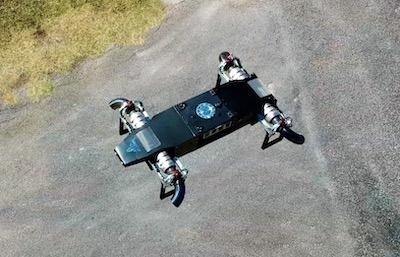Mon, Dec 02, 2019
Company Lists Cruise Speed In Excess Of 260 Knots
Fusion Flight has been developing a turbine-powered VTOL drone that it compares to a "scaled-down version of the Harrier Jump-Jet".

The The AB5 JetQuad is a new type of aircraft, according to the company website. This is not a quadcopter, nor a helicopter, nor an airplane. Four microturbine jet-engines produce a combined 200-Horsepower at full throttle and are all coupled with proprietary Thrust Vectoring Systems, which it calls the "H-Configuration". This is the first ever configuration in which the jet-engines alone provide the power for both vertical and horizontal flight as well as complete attitude control of the vehicle. The result is a compact, fully-autonomous, all-diesel drone that can take-off and land virtually from any surface and capable of high speeds and payload capacity. FusionFlight has been developing JetQuad since 2016.
In addition, the high-precision Thrust Vectoring System TVS) offer unprecedented advantages over modern multi-copters. The TVS are actuated by high-torque servos which have significantly faster response time then the electrical motors/propellers used on these drones. As a result, the JetQuad is more agile and more controllable. The TVS also allows the channeling of engine exhaust from all four turbines in the aft direction of the drone during horizontal flight. Consequently, JetQuad can utilize the power of all four engines and attain top-speeds unthinkable for similar-by-size VTOL aircraft.
The AB5 JetQuad is specifically designed so that it can easily be carried by a single person. Empty and unloaded, the drone weighs 50lbs. The production version of the JetQuad will contain retractable landing gear equipped with shock-spring systems to further cushion the aircraft during landing and provide additional flexibility for taking-off and landing from uneven terrain.
n the "Sky-Crane" configuration, the JetQuad would hover about 15ft at the payload drop off location, and slowly lower the payload to the ground using four electric reels. The Thrust Vectoring Systems are designed specifically to divert all hot gases away from the vehicle during hover allowing for the undercarriage payload to remain cool throughout the flight and payload deployment operation. In addition, the jet-engines can also generate plenty of on-board electricity to power sophisticated computer vision systems necessary for the safe operation of such high-speed drone.
Fusion Flight says a scaled-up version of the JetQuad, fitted with larger fuel tanks, may accommodate all aviation-grade jet-engines. Such a drone can support ultra-heavy cargo capacity missions without the expensive price-tag of renting out a similar (by size) helicopter. The same scaled-up platform would also enable the construction of the first flying car that does not have any external propellers; such a machine would look and feel like an ordinary car and be able to park in standard parking space.
The company lists the specifications for the prototype drone on its website. Those include:
- Dry Vehicle Weight 50 lb
- Payload Weight 40 lb
- Total Take-off Weight 130 lb
- Total thrust at Lift Off 160 lbf
- Endurance (loiter) 30 min
- Endurance (cruise) 15 min
- Cruise Velocity 300 mph+ (260+ Knots)
(Image provided by Fusion Flight)
More News
Aero Linx: Model Aeronautical Association of Australia MAAA clubs are about fun flying, camaraderie and community. For over 75 years, the MAAA has been Australia’s largest fl>[...]
Touchdown Zone Lighting Two rows of transverse light bars located symmetrically about the runway centerline normally at 100 foot intervals. The basic system extends 3,000 feet alon>[...]
“Discovery and innovation are central to our mission at Virgin Galactic. We’re excited to build on our successful record of facilitating scientific experiments in subor>[...]
How To Get A Story On Aero-TV News/Feature Programming How do I submit a story idea or lead to Aero-TV? If you would like to submit a story idea or lead, please contact Jim Campbel>[...]
Student Pilot Reported That During Rotation, “All Of A Sudden The Back Of The Plane Kicked To The Right..." Analysis: The student pilot reported that during rotation, “>[...]
 ANN's Daily Aero-Linx (05.02.24)
ANN's Daily Aero-Linx (05.02.24) ANN's Daily Aero-Term (05.02.24): Touchdown Zone Lighting
ANN's Daily Aero-Term (05.02.24): Touchdown Zone Lighting Aero-News: Quote of the Day (05.02.24)
Aero-News: Quote of the Day (05.02.24) ANN FAQ: Contributing To Aero-TV
ANN FAQ: Contributing To Aero-TV NTSB Final Report: Cirrus Design Corp SR20
NTSB Final Report: Cirrus Design Corp SR20



